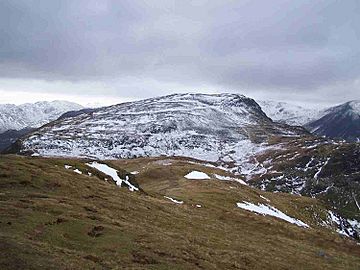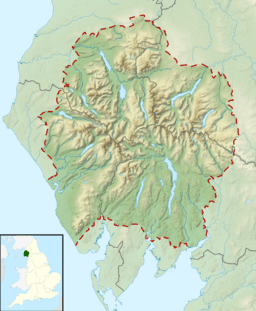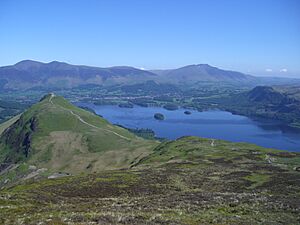Maiden Moor facts for kids
Quick facts for kids Maiden Moor |
|
|---|---|

Maiden Moor seen from the summit of Catbells
|
|
| Highest point | |
| Elevation | 576 m (1,890 ft) |
| Prominence | 16 m (52 ft) |
| Parent peak | High Spy north top |
| Listing | Wainwright |
| Geography | |
| Location | Cumbria, England |
| Parent range | Lake District, North Western Fells |
| OS grid | NY236182 |
| Topo map | OS Landranger 89, 90 OS Explorer Outdoor Leisure 4 |
Maiden Moor is a beautiful hill, also known as a 'fell', located in the English Lake District. It stands about 6 kilometers (about 3.7 miles) south of the town of Keswick. This fell is part of the high ground that separates the Newlands Valley and Borrowdale. Maiden Moor is 576 meters (1,890 feet) high. Even though it's not the tallest, it's special because Alfred Wainwright wrote a whole chapter about it in his famous book, Pictorial Guide to the Lakeland Fells.
Contents
What's in a Name? The Mystery of Maiden Moor
The name "Maiden Moor" is a bit of a puzzle! The word "Maiden" is often found in the names of very old prehistoric hill forts. However, there's no proof that a fort ever existed on Maiden Moor. Some people think the name might mean it was a place where special games or rituals took place, and young women, or "maidens," were involved.
Exploring Maiden Moor's Features
Maiden Moor has some interesting natural features. On the side facing the Newlands Valley, you can see a rocky area called Bull Crag. Below the col (a low point between two peaks) that connects Maiden Moor to Catbells, there's a hollow area known as Yewthwaite Combe. These features add to the unique landscape of the fell.
Mining History and a Famous Story
Yewthwaite Combe is also famous for its old lead mine, which is no longer used. You can still see large piles of waste rock, called spoil heaps, and old tunnels (adits) and shafts from the mine. The mine first opened in the late 1700s and closed in 1893.
This mining area became very well-known thanks to the author Beatrix Potter. She used it as the setting for her beloved story, "The Tale of Mrs. Tiggy-Winkle"! In the story, Mrs. Tiggy-Winkle, a hedgehog washerwoman, is said to have lived in one of the holes on the fell above the mine. Beatrix Potter dedicated this story to Lucy Carr, whose father was the vicar of Newlands Church.
How to Climb Maiden Moor
Maiden Moor is located between two other popular fells, Catbells and High Spy. Because of this, it's often part of a longer, well-known walk called the Newlands horseshoe. Many walkers reach Maiden Moor by following the ridge from these other fells.
You can also climb Maiden Moor directly. Popular starting points are the villages of Grange in Borrowdale and Little Town in the Newlands Valley. Both paths lead up to a low point called Hause Gate. This point connects Maiden Moor to Catbells. From Hause Gate, you climb up the northern ridge.
As you get closer to the top, the path splits. The main path continues towards High Spy, surprisingly not going over the very highest point of Maiden Moor. If you take the path to the right, it follows the edge above Newlands Valley. This path will lead you directly to the summit, which has a small pile of stones called a cairn.
Reaching the Summit
The very top of Maiden Moor is a flat, grassy area, so it can be a little tricky to find the exact highest point. However, once you are there, you will be rewarded with amazing views! You can look across the Newlands Valley and see the Coledale fells and the beautiful landscape beyond.



